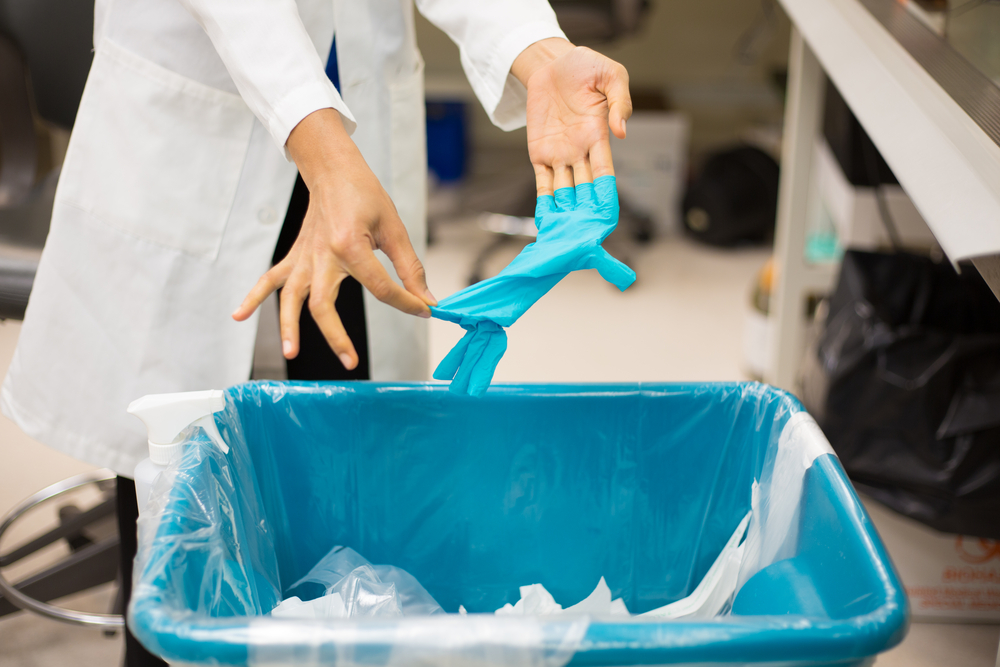North Carolina has rules for medical facilities on how to dispose of medical waste. The rules cover storage, packaging, transportation, the treatment of the waste, and finally, disposal of the waste. When disposing of medical waste, companies must follow the regulations for disposal of solid waste. The N.C.. Department of Environmental Quality Division of Waste Management administers the rules and medical waste disposal regulations.
Types of Medical Waste
Six types of medical waste exist that must be disposed of properly, including sharps, biohazard, trace chemo, RCRA hazard, pharmaceutical and radioactive. Each type has its own color-coded bin for storage at the medical facility. For example, biomedical waste disposal starts out in a red container at the medical facility. This includes infectious waste, blood products, contaminated personnel protective equipment, IV tubing, cultures and stacks. Trace chemo goes into yellow containers and may include empty vials, ampules, empty syringes and needles, empty IVs, gowns, gloves, tubing, aprans, wipes and packaging.
Proper Medical Waste Disposal
It may seem as if though most anything that leaves medical facilities is regulated medical waste. However, only 10 to 25 percent is regulated medical waste that needs proper medical waste disposal. The rest is paper and other product that doesn’t come into contact with patients. This is categorized as general waste by the WHO. It doesn’t have any risk to human health since it is never in contact with blood or other body fluids.
Medical personnel must dispose of medical waste in color-coded containers. If you put sharps into the general waste instead of the medical waste disposal containers, then all of that waste becomes contaminated.
Medical waste must be stored in a secure area where the general public doesn’t have access to it. It must also be kept separate from areas that are regulated for food consumption. The secure area must also have a refrigerator or a freezer for medical waste that must be kept below certain temperatures.
Once a biohazard waste disposal company picks up the medical waste, it transports and treats it based on certain regulations by OSHA and other agencies that may control medical waste regulations. Treatment varies depending on the type of medical waste, thus it is important to keep waste in the appropriate color-coded receptacles. Some waste may be incinerated and some may be treated by irradiation, autoclaving or chemical methods.
Once the waste has been treated and deemed non-hazardous, it is then disposed of according to solid waste disposal regulations. Fluids are solidified, thus they become solid waste. Some fluids may be disposed of into a sanitary sewer system, which is separate from the general sewer system.
How To Dispose Of Medical Waste At Home
In some cases – depending on your community’s regulations – household medical waste must be properly disposed of. Many homes have patients who use needles regularly for diabetes and other illnesses. If your community requires proper disposal of sharps containers, as they should, the community may have a drop box or a supervised collection site. In some cases, sharps may also be disposed of at household hazardous waste sites.
Contact MedWaste Services
If you are a medical facility, contact MedWaste Services to discuss transportation, treatment and disposal of your medical waste. If you are an individual and are required to dispose of household medical waste in special containers, contact our office to discuss the proper method of disposal and to inquire about medical waste containers.
We are 100 percent veteran-owned and operated and have an OSHA compliance portal so that you may keep your employees OSHA trained and certified. Our pricing is consistent and we do not have surcharges such as fuel and service.

